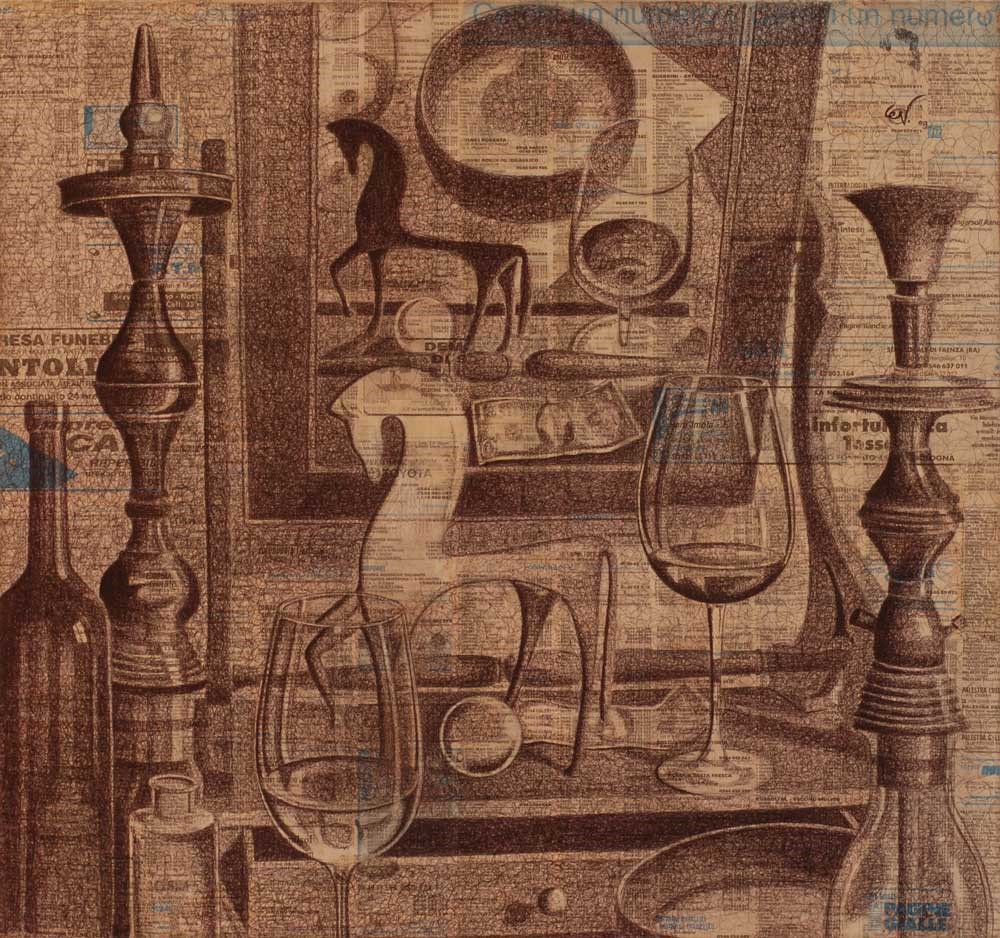
La forma dell’invisibile, Emanuele Gaudenzi
The shape of the unseen
Appare subito evidente come la pittura di Enrico Versari si distingua per l’estrema perizia tecnica, l’elegante grazia compositiva, l’armonia cromatica e chiaroscurale, i magici effetti filigranati e la calibrata, rigorosa, impaginazione. Elementi, tutti, che conferiscono alle sue tavole dipinte una nitida piacevolezza, immediatamente fruibile, accattivante e fascinosa fin quasi ai limiti dell’ornamentale. Risulta pure chiaro come quella di Versari sia una pittura colta, contemplativa, potremmo perfino dire ascetica, costellata di simboli e metafore, punteggiata da esplicite citazioni e da frequenti rimandi iconografici. Caratteristiche, anche queste, che imprimono sostanza ed autorevolezza alla sua ricerca. Ma è ovvio anche che il convergere e il sommarsi del virtuosismo decorativo, del talento grafico e dell’elaborazione intellettuale, non riuscirebbero ad emozionarci se mancasse l’afflato poetico, la tensione emotiva e la militanza esistenziale che invece ritroviamo in ogni sua creazione, e che ci trascinano in quel suo sogno di cose e di apparizioni.
Presentando in chiusura di rassegna l’Autoritratto, Enrico Versari ci introduce nel misterioso silenzio delle sue visioni. In forza della sua esplicita linearità (e così proiettato verso nuovi percorsi espressivi), l’Autoritratto ci permette di compiere una ricognizione a ritroso attraverso le coordinate operative degli ultimi quattro anni: periodo dedicato, con estrema prevalenza, alla pratica dello still-life, al metafisico enunciare forme e combinazioni, fra indagine di puri valori pittorici e suggestivi richiami al realismo magico.
Ora, proprio l’emblematica ricorrenza di combinazioni e di forme fanno apparire queste tavole dipinte come le pagine di un atlante spirituale, una sorta di raccolta iniziatica, un album in cui raccogliere i frammenti sparsi di una geografia interiore.
Un geografia perduta e solo in parte ritrovata.
Tramite le tecniche miste del pastello e della tempera, dell’inchiostro e del collage, l’approccio stilistico di Versari si avvale costantemente di un registro analitico e descrittivo. Un’acribia, un assemblaggio minuzioso ed una stesura calligrafica che rimandano all’ossessivo intento di penetrare nel cuore delle cose, al tentativo di scandagliarne il significato nascosto, alla coraggiosa volontà di attingere al loro imperscrutabile segreto.
Ma ecco che ogni volta, inevitabilmente, la visione sembra rimanere sospesa, cristallizzarsi in una compiutezza più matematica che reale, lontana ed estranea dalla rappresentazione oggettiva. È come se si nascondesse qualcosa nelle diverse combinazioni, così come nel delinearsi stesso delle forme: qualcosa che non viene rappresentato, qualcosa destinato a rimanere fuori campo, invisibile prima ancora che inesprimibile.
Si tratta di un’involontaria esclusione, di un’inevitabile assenza che le improvvise apparizioni umane finiscono per enfatizzare fino alle estreme conseguenze.
Nel tentativo di ristabilire un ordine reale, a nulla vale l’inserzione di stralci dell’annuario telefonico, il drappeggio di carte geografiche rovesciate o i frammenti sparsi di repertori enciclopedici e di pentagrammi. L’atto di offerta di Aqua Mater, i confini lontani de Il mondo di Lucia, l’evanescente sogno ne Il viaggio di Isabet, e perfino le labili, brumose, apparizioni di Pagine bianche, non scalfiscono l’illusoria compagine dell’insieme.
Tutto appare così immoto forse per effetto di una velocità inaudita.
Tutto è troppo chiaro, troppo evidente, per risultare comprensibile.
L’impressione è di essere in un labirinto senza spazio e senza tempo, senza entrata e senza uscita, dove qualcosa è accaduto, qualcosa sta per accadere, qualcosa accadrà. Non ci stupiremmo se, accanto al Pesce rosso che si riflette nel globo o nella banconota di Due dollari che si raddoppia allo specchio, da qualche parte facesse capolino l’immagine dei coniugi Arnolfini, o se si svelasse d’un tratto un’anamorfosi o un trompe-l’oeil in grado di stravolgere il significato della messinscena.
Questa è la vera realtà, suggeriscono le immagini – questa sola. L’artista non può far altro che condurci fin sulla soglia delle cose, al cospetto del loro mistero, appena un attimo prima del compiersi irrevocabile degli eventi.
Spetta a noi saper cogliere, di volta in volta, nel nostro cuore, il valore intimo dell’assenza, il segreto che vi si nasconde, la forma esatta dell’invisibile.
Emanuele Gaudenzi
“Enrico Versari, La forma dell’invisibile”, Tipografia Faentina Editrice, 2011.
The shape of the unseen
It appears immediately evident how Enrico Versari’s painting distinguishes itself for its extreme technical ability, the elegant grace of its composition, the chiaroscuro and chromatic harmony, the magical watermarked effects and the calibrated, rigorous layout.
All these elements contribute in giving the pieces a crisp pleasantness, immediately accessible, appealing and captivating almost to the limit of decoration.
It is also clear how Versari’s painting is a cultured, contemplative one, we could nearly call it ascetic, dotted with symbols and metaphors, spotted with explicit quotations and frequent iconographic references. These are too characteristics which imprint substance and authority to his research.
It is also obvious that the converging and the sum of the decorative virtuosity, of the graphic skill and the intellectual elaborations, they would not succeed in moving us without the poetic afflatus, the emotional stress and the essential militancy that we find again in every masterpiece and that drag us in his dream of things and appearances.
Presenting at the end of the exhibition the Autoritratto (Self Portrait), EV introduces us to the mysterious silence of his visions. Thanks to its explicit linearity (and thus projected towards new expressive paths), Autoritratto allows us to patrol backward through the operational coordinates of the last four years: period mostly dedicated to still life, to the metaphysic declaration of shapes and combinations, between inquiry of pure pictorial values and evocative recalls to the magical realism.
Now, it is the emblematic recurrence of combinations and of shapes that makes these pieces to appear painted like the pages of a spiritual atlas, some sort of initiation collection, an album in which to collect the fragments scattered of an inner geography.
A lost geography and only partially found again.
Through the mixed techniques of the pastel and of the tempera, of the ink and of the collage, Versari’s stylistic approach constantly makes use of an analytical and descriptive register.
A precise, meticulous assembly and a calligraphic drawing up that sends us back again to the obsessive attempt to penetrate the heart of things, to the attempt to probe their hidden meaning, to the brave will to reach to their inscrutable secret.
But every time, unavoidably, the vision seems to remain suspended, to crystallize itself in wholeness more mathematical than real, distant and foreign from the objective representation. It is as if something else were hiding in the various combinations, in the outline of the shapes: something that is not represented, something destined to remain off screen, invisible as if unexplainable.
We are talking about an involuntary exclusion, an unavoidable absence emphasized by sudden human apparitions to the extreme results. In the attempt to recreate a real order, it is of no use to insert torn pages of telephone directories, the drapery of upside down maps or scattered fragments of encyclopedic directories and of pentagrams.
The Aqua Mater’s offer act, the far away borders of Il mondo di Lucia, the evanescent dream of Il viaggio di Isabet and even the fleeting, misty, apparitions of Pagine Bianche, don’t graze the deceptive structure of the whole.
All appears so motionless perhaps because of an unheard speed.
It is all too clear, too obvious, to result comprehensible.
The impression is to be in a spaceless and timeless labyrinth, without entrance and without exit, where something has happened, something is about to happen, something will happen. We would not be surprised if, next to the Pesce rosso which reflects itself in the globe, or in the banknote of Due Dollari that doubles itself in the mirror, the Arnolfini’s image would peep from somewhere, or if all of a sudden a tromp l’oeil would appear and twist the meaning of the representation.
This is the real truth, the images imply-just this one. The artist cannot do anything else other than takes us to the threshold of things, in front of their mystery, just a moment before the irreversible happening of the events.
It’s up to us capture, each single time, in our heart, the intimate value of the absence, its hidden secret, the accurate shape of the unseen.
Emanuele Gaudenzi
“Enrico Versari, La forma dell’invisibile”, Tipografia Faentina Editrice, 2011.
Leave a Reply
You must be logged in to post a comment.
